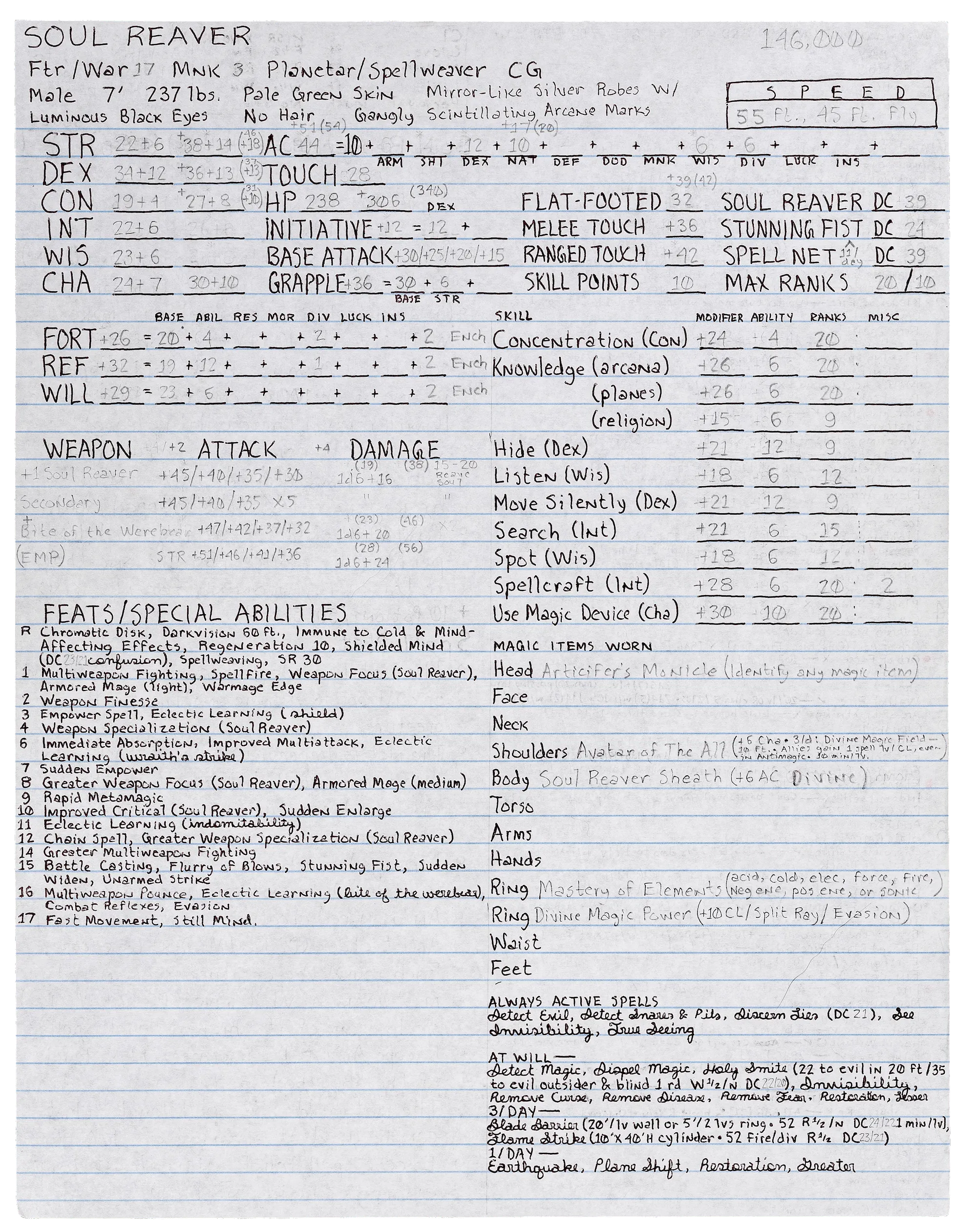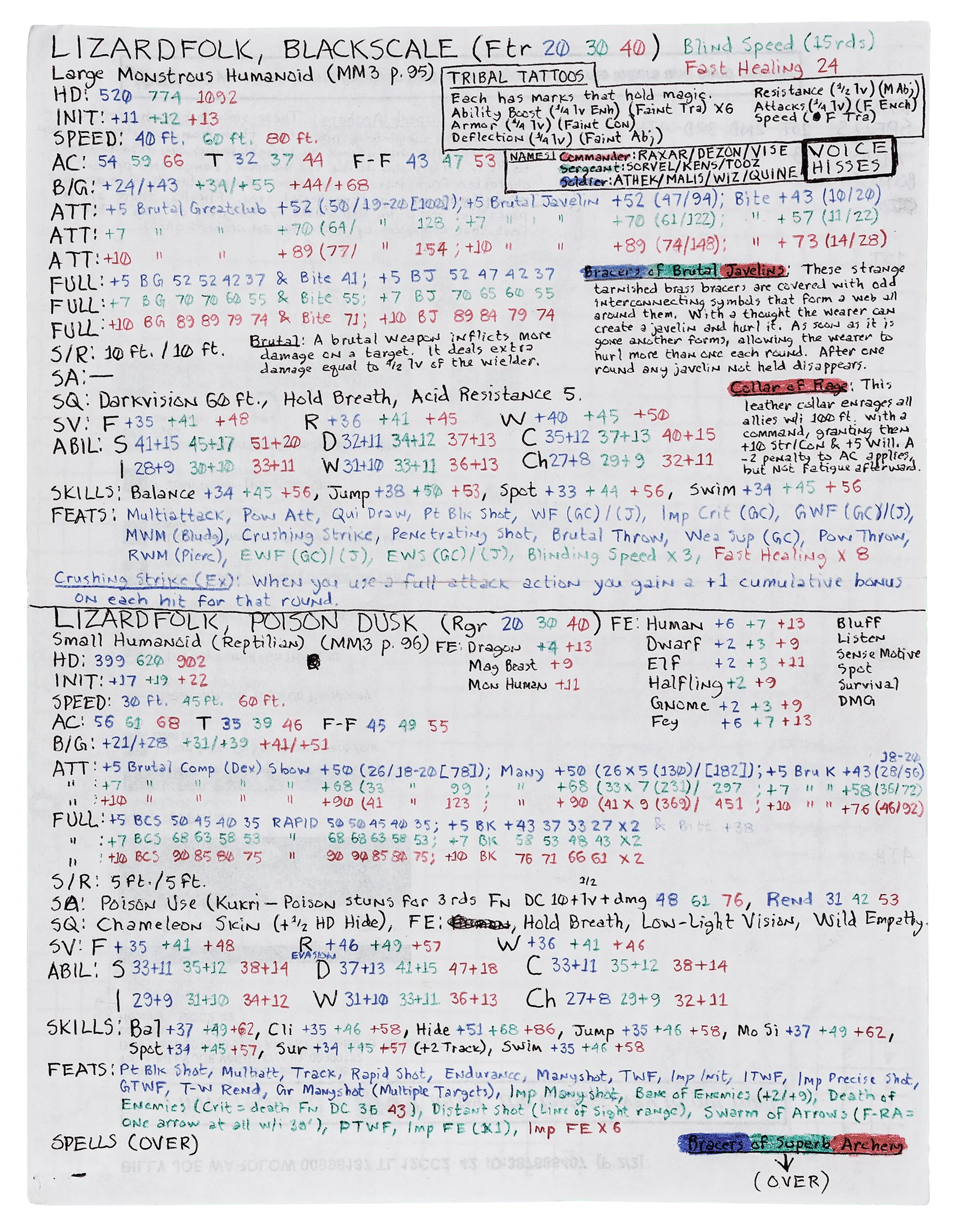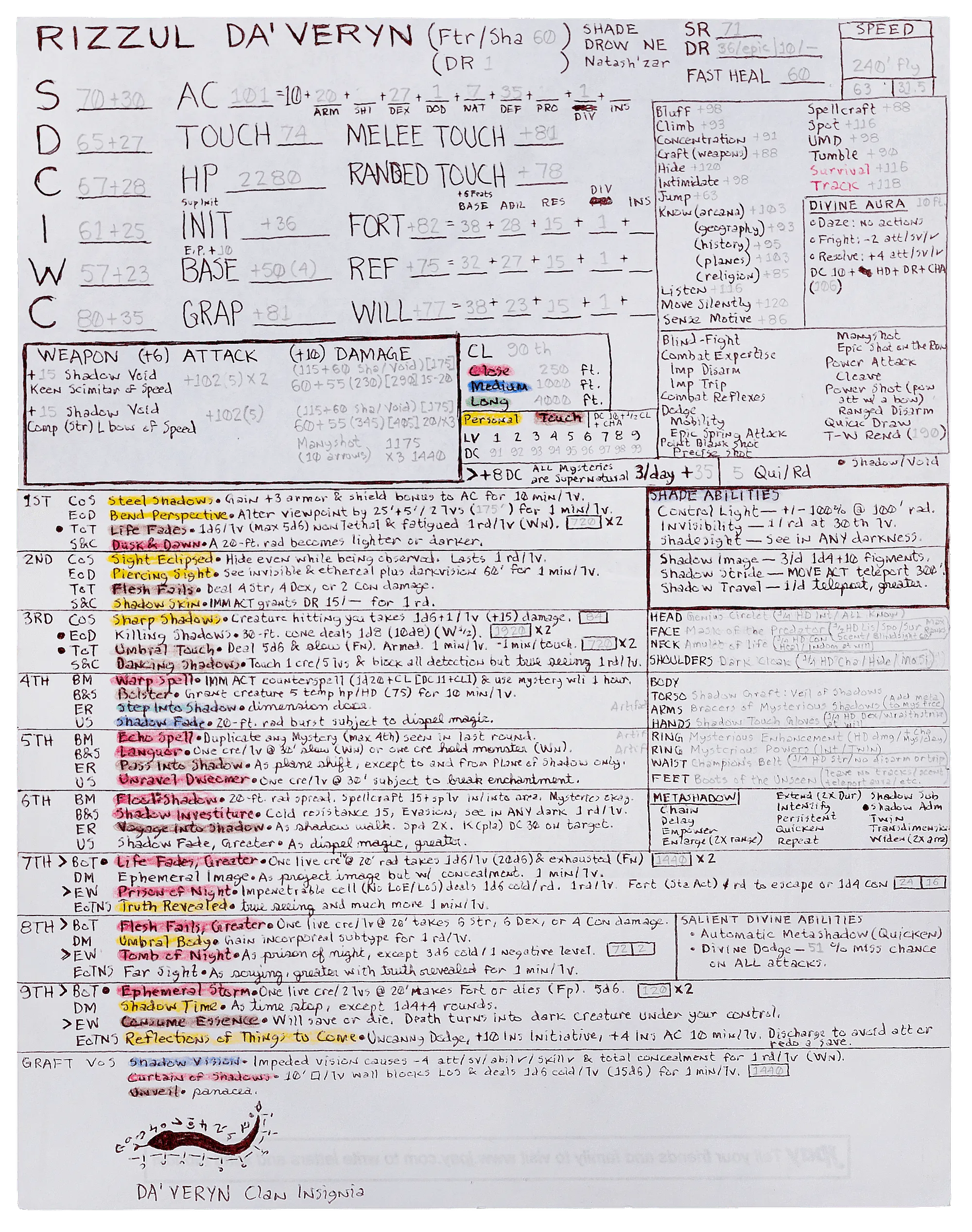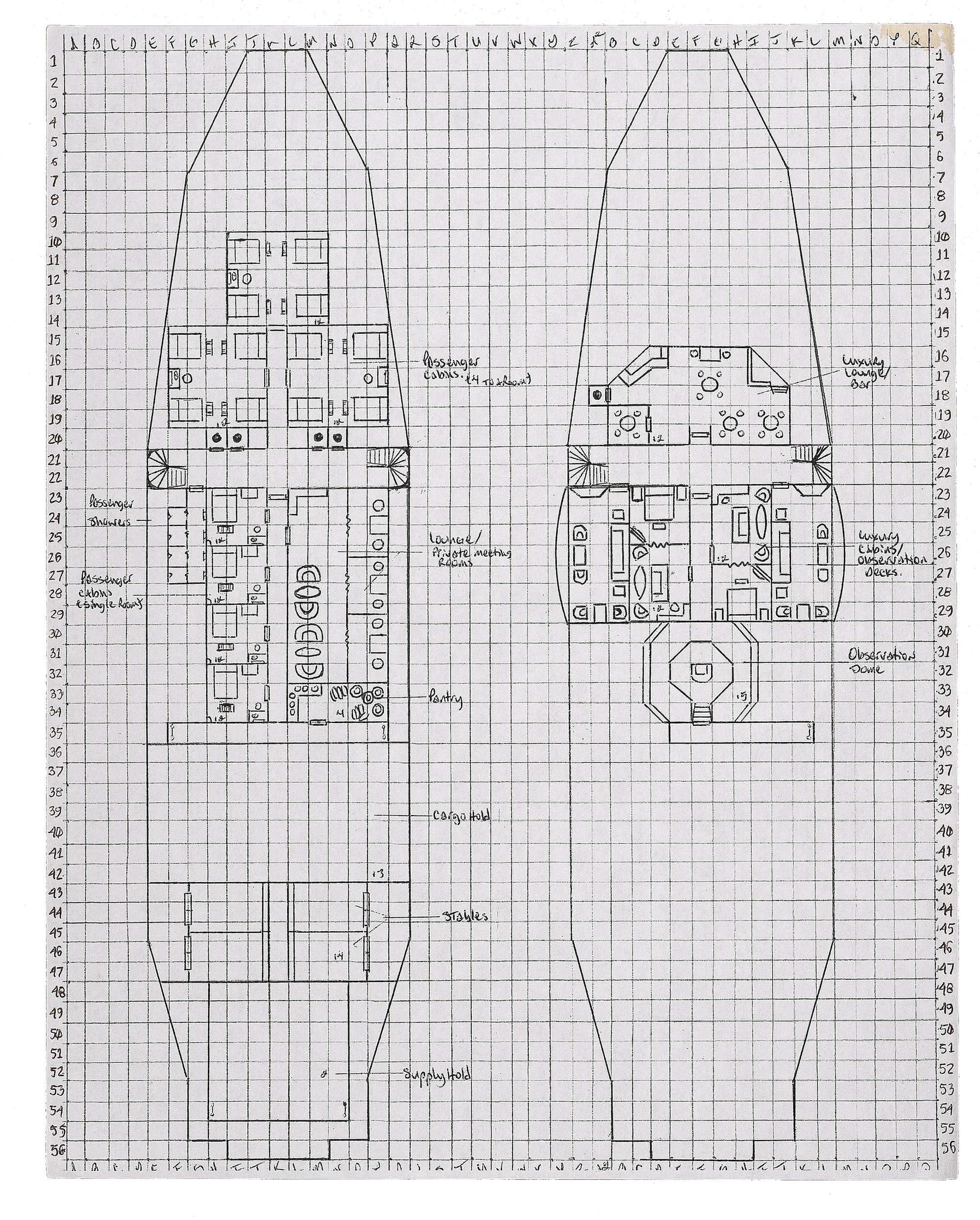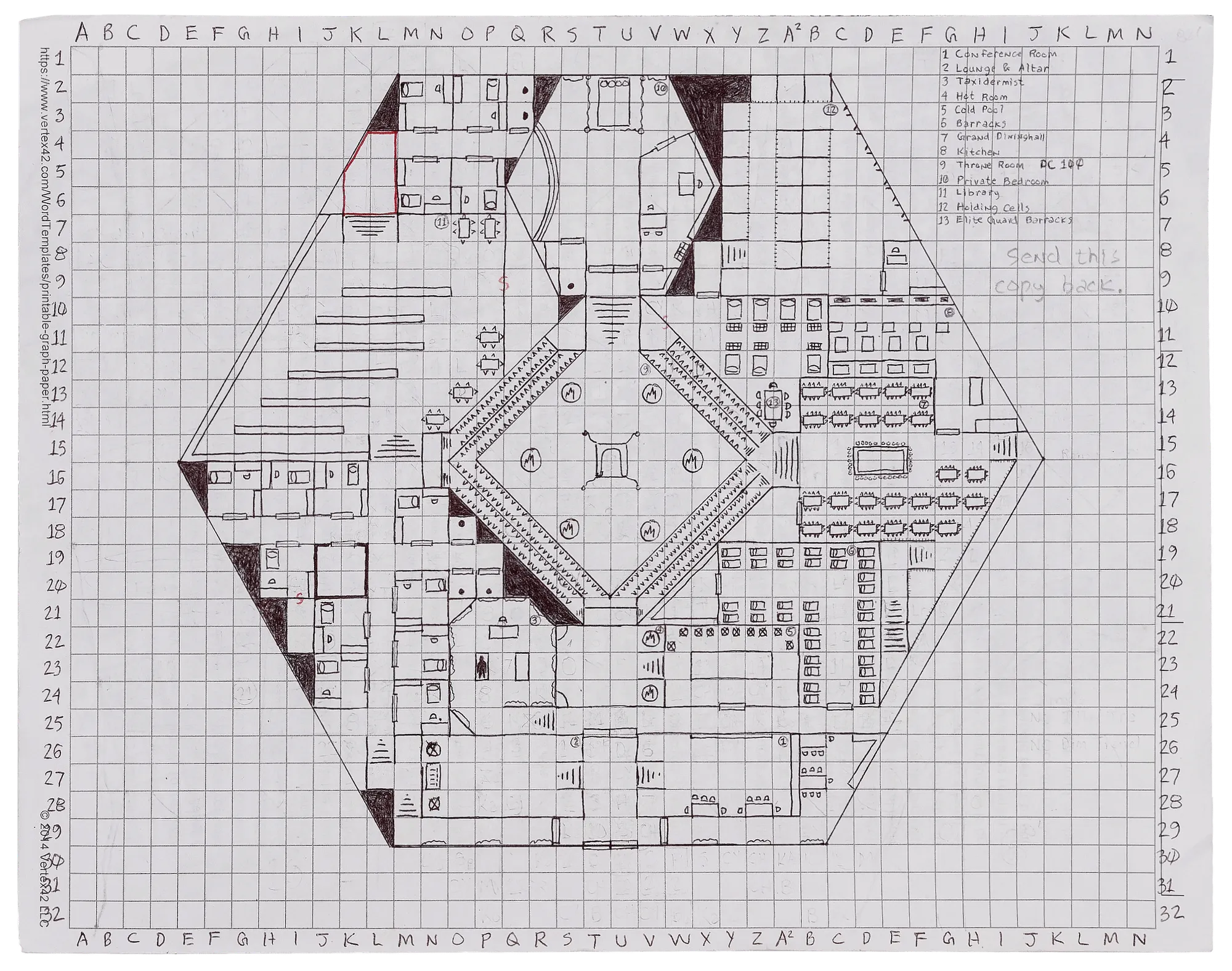The first time Tony Ford played Dungeons & Dragons, he was a wiry Black kid who had never seen the inside of a prison. His mother, a police officer in Detroit, had quit the force and moved the family to West Texas. To Ford, it seemed like a different world. Strangers talked funny, and El Paso was half desert. But he could skateboard in all that open space, and he eventually befriended a nerdy White kid with a passion for Dungeons & Dragons. Ford fell in love with the role-playing game right away; it was complex and cerebral, a saga you could lose yourself in. And in the 1980s, everyone seemed to be playing it.
D&D had come out a decade earlier with little fanfare. It was a tabletop role-playing game known for its miniature figurines and 20-sided dice. Players were entranced by the way it combined a choose-your-own-adventure structure with group performance. In D&D, participants create their own characters — often magical creatures like elves and wizards — to go on quests in fantasy worlds. A narrator and referee, known as the Dungeon Master, guides players through each twist and turn of the plot. There’s an element of chance: The roll of the die can determine if a blow is strong enough to take down a monster or whether a stranger will help you. The game has since become one of the most popular in the world, celebrated in nostalgic television shows and dramatized in movies. It is played in homes, at large conventions and even in prisons.
By the time Ford got to high school, he had drifted toward other interests — girls, cars and friends who sold drugs and ran with gangs. Ford started doing those things, too. He didn’t get into serious trouble until Dec. 18, 1991. Sometime before 9 p.m., two Black men knocked on the door of a small home on Dale Douglas Drive in southeast El Paso, asking for “the man of the house.” The woman who answered, Myra Murillo, refused to let them in. A few minutes later, they returned, breaking down the door and demanding money and jewelry. One opened fire, killing Murillo’s 18-year-old son, Armando.
Within hours, police picked up a suspect, who said Ford was his partner. They arrested Ford, who was 18 at the time, the following day. He has maintained that the two men who entered the house were brothers, and that he was outside in the car the whole time. There was no physical evidence clearly connecting him to the crime. He was so confident that a jury would believe him that he rejected a plea deal and took his case to trial in July 1993. He lost. By October, at age 20, he was on death row.
Back then, death row for men was located in a prison near Huntsville, Texas, where hundreds lived in tiny cells. The men were allowed to hang out together, watch television, play basketball and go to work at prison jobs. And because they were locked behind bars rather than solid doors, they could call out to one another and talk. That was how, one day, Ford caught familiar words drifting down from the cells above him, phrases like, “I’ll cast a spell!” “Aren’t there too many of them?” and “I think you have to roll.”
It was the sound of Dungeons & Dragons.
Roughly 200 people are on death row in Texas today, less than half the peak population in 1999. The number of people sentenced to death each year has declined over the past two decades in Texas and across the country as the cost of prosecuting and defending death-penalty cases has ballooned and public support for capital punishment has dropped.
While fewer prisoners arrive on death row each year, they languish there far longer. Some states have had difficulty procuring execution drugs, and landmark court rulings have banned executions of people deemed “insane” or intellectually disabled. Lawyers can spend years arguing that their clients have such low cognitive capacity that it would be cruel to kill them, or that new DNA technology could prove their innocence. In the early 1980s, prisoners across the country spent an average of six years on death row before they faced execution. Now, they can wait for two decades.
In many states, prisoners spend those years living in isolation so extreme the United Nations condemns it as torture. “All international standards and norms say that the use of isolation should be a last resort,” says Merel Pontier, a Texas-based lawyer who has studied death-row conditions. Decades of research shows long-term isolation can cause hallucinations and psychosis. Prisoners living in severe isolation — like the men on Texas’ death row — turn to suicide at a higher rate than those in the general population. Some simply drop their appeals and volunteer for execution.
Not every state keeps its death-row population in solitary. Some prisoners sentenced to death in Missouri and California, for example, are mixed with the general population. In Arizona, people on death row can go to the rec yard and day room in groups for a few hours a day. In North Carolina, they can take prison jobs; in Florida they can have TVs in their cells; and in Louisiana, they’re allowed to have contact visits, where they can hug their friends and families.
The death row that Ford entered in Huntsville offered some of those freedoms until an incident in 1998 changed everything. The night of Thanksgiving, seven men staged a breakout. One person stayed behind in the rec yard to shoot hoops, making enough noise to cover the sound of a purloined hacksaw cutting through a chain-link fence. When the guards spotted the men and started firing at them, six surrendered. Only one made it all the way into the woods. Off-duty prison workers found his body a week later, drowned in a nearby stream.
By the time the following summer rolled around, the men on Huntsville’s death row knew their lives were about to change for the worse. Officials spoke of imminent transfers to a new, higher-security death row in Livingston. As Ford remembers it, he was on the second bus there.
In the decades since then, the men on death row at the Allan B. Polunsky Unit have spent their days in near-total isolation, only allowed to leave their cells for two hours of recreation, three days a week, alone, in day rooms or fenced-in cages — if the guards feel like letting them out or aren’t too short-handed. Sometimes, the men say, they go weeks without setting foot outdoors or being able to take a shower. (The Texas Department of Criminal Justice denies these claims.) The prison permits one five-minute phone call every 90 days. Their only regular physical contact with another human is when the guards put them in handcuffs. Even when the men manage to nurture relationships with girlfriends or wives in the free world, they’re never able to touch.
Just after the start of the pandemic, a new warden made a few changes, setting up TVs in some of the day rooms and letting the men exchange written notes with a handful of prisoners who run a radio station. When the Texas prison system got tablets last year, the men on death row were given limited access to email, which was closely monitored. Even so, Polunsky remains home to one of the most restrictive death rows in the nation. To report this article, I spent several years exchanging letters with men on death row in Texas. Phone calls with reporters aren’t permitted, and I could only conduct monitored, in-person, one-hour interviews with specific individuals every three months. For some of these men, I was their most regular visitor.
To cope with the isolation they face daily, the men on death row spend a lot of their time in search of escape — something to ease the racing thoughts or the crushing regrets. Some read books or find religion. Some play games like Scrabble or jailhouse chess. Others turn to D&D, where they can feel a small sense of the freedom they have left behind.
When Ford first overheard the men on the old Huntsville death row playing D&D, they were engaged in a fast, high-octane version. The gamers were members of the Mexican Mafia, an insular crew that let Ford into their circle after they realized he could draw. The gang’s leader, Spider, pulled some strings, Ford recalls, and got him moved to a neighboring cell to serve as his personal artist. Ford earned some money drawing intricate Aztec designs in ink. He also began to join their D&D sessions, eventually becoming a Dungeon Master and running games all over the row.
Playing Dungeons & Dragons is more difficult in prison than almost anywhere else. Just as in the free world, each gaming session can last for hours and is part of a larger campaign that often stretches on for months or years. But in prison, players can’t just look up the game rules online. The hard-bound manuals that detail settings, characters and spells are expensive and can be difficult to get past mailroom censors. Some states ban books about the game altogether, while others prohibit anything with a hard cover. Books with maps are generally forbidden, and dice are often considered contraband, because they can be used for gambling. Prisoners frequently replace them with game spinners crafted out of paper and typewriter parts.
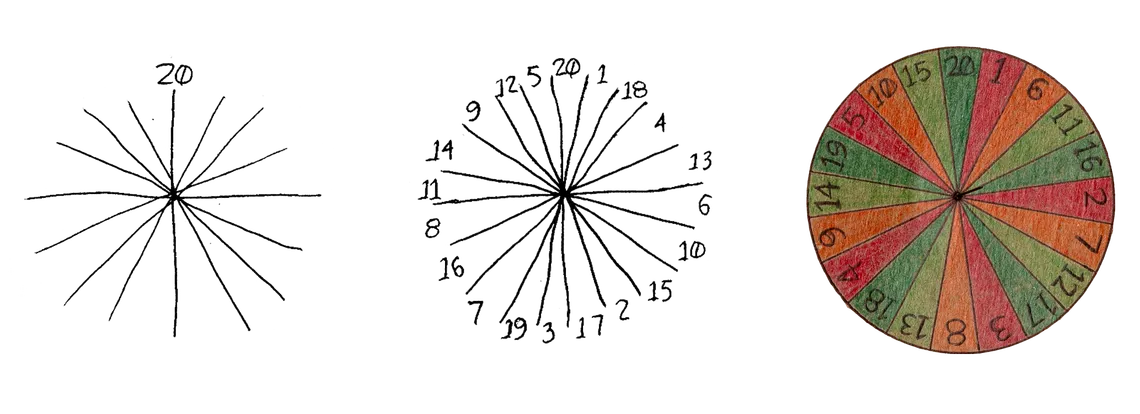
On the old death row, prisoners could call out moves easily through the cell bars; they also had the chance to play face to face, sitting around the metal tables in the common room or under the sun of the outdoor rec yard. That was where, sometime in the late 1990s, Ford saw four men playing Dungeons & Dragons together. He asked someone who they were and learned that the 6-foot-5 White guy from the country, with a buzz cut and glasses, was Billy Wardlow.
Ford didn’t know Wardlow — they were never housed near each other for very long — but he had heard about him. “From what everyone that knew something about him said, there was universal agreement that Billy was one of the ‘good guys,’” Ford wrote in a court document in 2019. Wardlow kept his word and didn’t start trouble. He even participated in a hunger strike organized by Black prisoners in the mid-1990s to protest the growing frequency of executions. (After the Supreme Court reauthorized the death penalty in 1976, Texas accelerated the pace of executions, which jumped from one in 1982 to 19 in 1995, peaking at 40 in 2000.) “It was surprising to a lot of us Black guys that there was some White guy joining in because in prison it is HARD to organize any efforts across racial and ethnic lines,” Ford wrote.
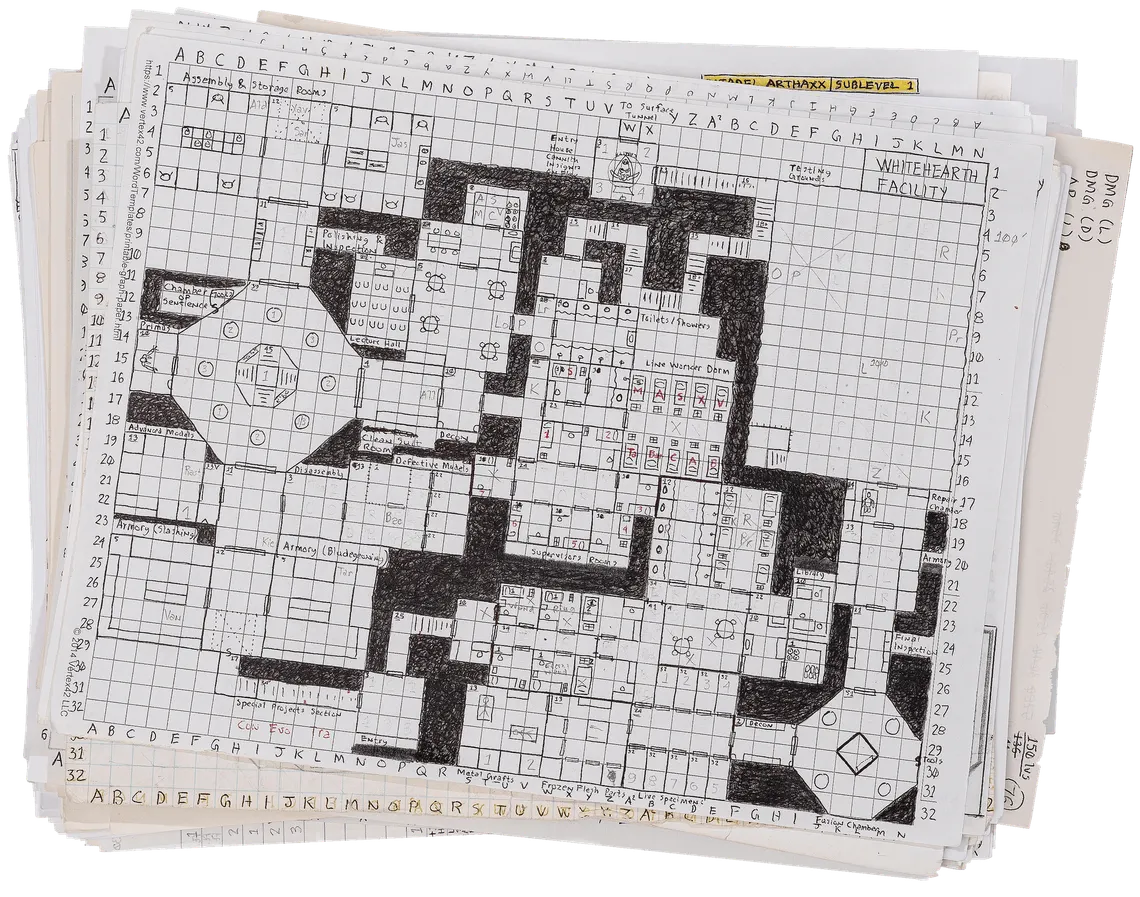
The men in Ford’s D&D group struggled to bring their gaming world with them to Polunsky. When they arrived, they found that many of their belongings had gone missing or been confiscated. They lost game notes and hand-drawn maps, spinners and character sketches. And now they could not sit at a table together to play. They had to rely instead on a variety of clandestine communications, including written messages called “kites,” passed from cell to cell.
For Ford, there was one silver lining. At Polunsky, he could finally play D&D with a death-row legend: Billy Wardlow.
By death-row standards, Wardlow’s past was not remarkable. He had grown up in the small town of Cason, Texas, where his father worked in factories and his mother was a custodian at the First Baptist Church. He had an older brother and would have had two, but his parents’ second child died at 6 months. His mother, Wardlow said, visited the boy’s grave to claw at the dirt with her fingers, wailing as she prayed to God for another child. Then came Wardlow.
“As far back as I can remember, Mother told me that I was a gift from God,” he wrote in a court filing. “But I didn’t always feel that way.” His mother was prone to violent tantrums, beating him with belts, car antennas and PVC pipes. Once, when Wardlow was 10, she pulled a gun on him after she caught him swiping money from her purse. “She told me my father was an alien from another world and that I would never find anyone to love me but her,” he wrote in a letter to me. “I believed it.”
In school he was a loner, though he did well in class and was good with electronics (other prisoners told me he earned a reputation for being able to fix anything). When Wardlow was 16, he met Tonya Fulfer, a classmate, in the high school library. Like him, she had problems at home. During senior year, they both dropped out of school and left town.
Before long, they were back in Cason where, on the morning of June 14, 1993, Wardlow knocked on Carl Cole’s door and asked to use the phone. The young couple hoped to steal his car and flee to Montana, where they would start a new life together. But the plan went wrong, and Wardlow, who was 18 at the time, shot the older man. Afterward, he and Fulfer fled the state in Cole’s pickup truck. They were arrested two days later in South Dakota. Wardlow was sentenced to death on Feb. 11, 1995. He arrived on death row two days later.
Unlike Ford, Wardlow never played Dungeons & Dragons before prison. But months later, another man on the row handed him a book full of fantasy names and magical creatures. “This is the game,” Wardlow remembered him saying. “Be ready tomorrow.” Over the next two decades, Wardlow went on to play dozens of games with many characters. One he became known for among his death-row peers was Arthaxx d’Cannith, a magical prodigy. Though his home planet, the war-torn Eberron, was an established setting among D&D players, Arthaxx was Wardlow’s creation — a character he developed through pages and pages of game notes and hand-drawn illustrations.
Born to a professor and an inventor, Arthaxx had a twin sister who died as a baby. After the girl’s death, Arthaxx’s mother refused to let the tragedy derail her academic career. Instead, she threw herself into her work, leaving her son to be raised by tutors. They gave him all the tools for magical greatness, and after graduating early from a prestigious wizarding college, he got a job with a top guild, where he invented secret weapons for war.
Arthaxx could cast spells to control the elements, manipulate electricity or send walls of fire raging across enemy battlefields. Every day, Arthaxx used his gifts to help the higher-ups of House Cannith perfect the invention they hoped would end a century of war. At night, he came home to his wife, his childhood sweetheart.
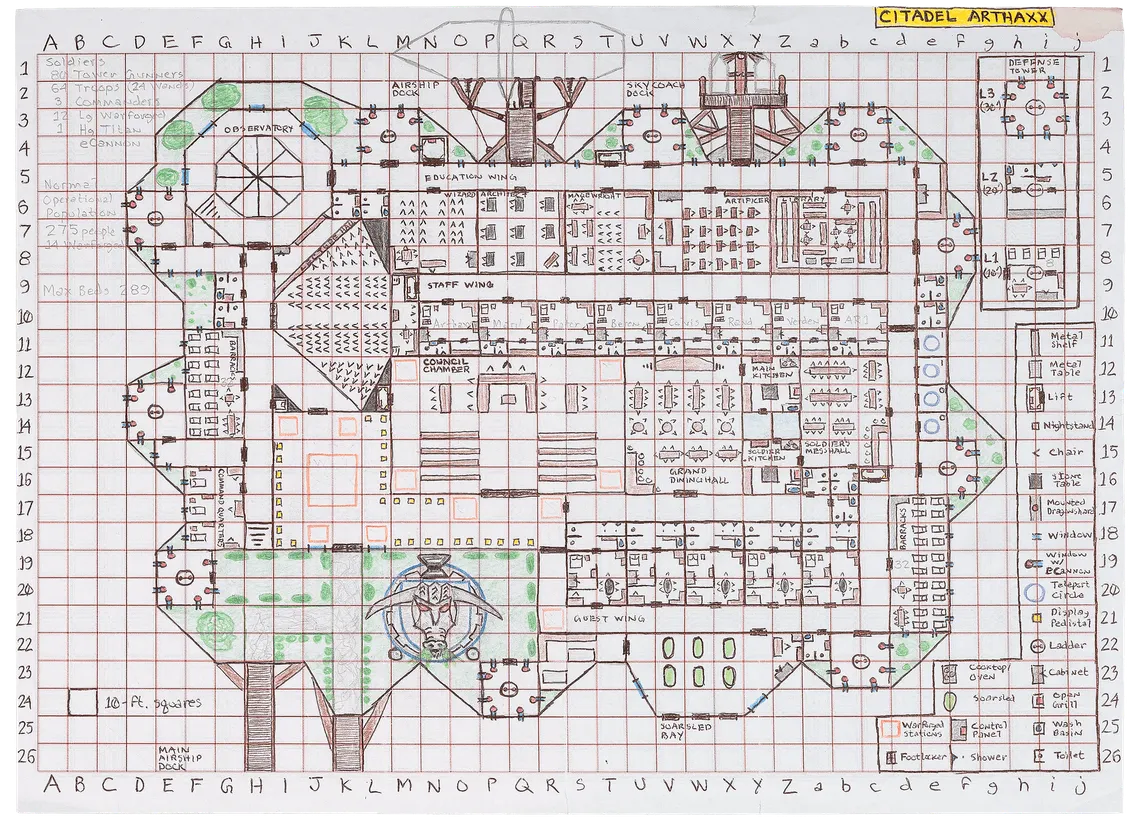
Arthaxx was, to some extent, a version of Wardlow whose mother was not shattered. Whose parents loved him and sent him to a prestigious school. Whose proficiency with electricity earned him a comfortable living. Whose best options never included running away. Whose worst mistake never landed him on death row.
“‘Friends is a loaded word in prison,” Ford wrote to me in a long, typed letter sent three years ago. “So many people have been betrayed by their ‘friends.’ What we have around us are more associates, close associates.”
But D&D turned associates into a crew. After they started playing together at Polunsky, Ford noticed that when Wardlow was in charge of the game, the other guys didn’t bicker as much. As Dungeon Master, Wardlow created vast and intricate worlds. He could play without books or hand-drawn maps and could run the game on the fly, improvising the narrative as he went along.
Some D&D crews on death row liked to play at random times, diving into a fantasy world whenever the mood struck. But when Wardlow ran the games, he liked to set a schedule, usually starting around 9 a.m. Mondays, Wednesdays and Fridays, sometimes playing until they fell asleep. It was the rare activity Ford and his friends could look forward to, a time when no one would talk about legal cases or lost appeals.
Sometimes, through their characters, they opened up about problems they would never otherwise discuss — abusive parents, fractured childhoods, drug addictions — unpacking their personal traumas through a thin veil of fantasy. “With Billy, D&D has become our therapy,” Ford wrote in 2019.
Death row didn’t offer any of the educational or mental-health programs available in regular prisons; rehabilitation isn’t the goal for those on death row, and special programming is not always logistically feasible for people held in solitary confinement. For these players, the games served as their life-skills course, anger-management class and drug counseling, too. Like Ford and Wardlow, a lot of the men on the row came to prison at a young age and never had a chance to be adults in the free world.
In 2005, the Supreme Court banned capital punishment for crimes committed by people under 18, saying that “evolving standards of decency” forbade it. Though Texas had to stop executing minors, the state could still sentence older teenagers — those who were 18 and 19 — to death. Some of the men in the D&D crew never had their own apartments or bank accounts, never paid rent or bought car insurance or cashed a paycheck. Once they got to prison, their lives were, in essence, frozen.
Wardlow gave the men something to aspire to, not only because his games offered players a sense of structure and purpose, but also because his legal case had the potential to establish an important precedent. Prisoners in Texas can be sentenced to death only if a jury decides they are guilty and will pose a danger to society. That controversial “future danger” finding has been part of Texas death-penalty law since the 1970s. But brain science has evolved over the past half-century, and experts question whether it’s possible to make that determination with any accuracy if someone was just 18 or 19 at the time of a crime. Research shows that the prefrontal cortex — a part of the brain associated with emotional regulation and understanding consequences — keeps developing into a person’s 20s. Wardlow’s legal team leaned on science in their court filings, arguing that an 18-year-old’s brain wasn’t notably different from that of a 17-year-old.
When the men heard about the details of Wardlow’s appeal, they began to feel hopeful. “You had a lot of guys that were really like: ‘Hey, man. This is our shot, this is our shot right here,’” Ford told me last year, peering through the scratched visiting-room glass. “The Supreme Court’s going to do this.”
In the meantime, D&D was their best chance to learn about the world. They had to manage “money,” to make sure they had enough gold to rent a tenement or buy a horse. And when they were running low, they had to consider the best path for getting more: finding work at the local tavern, for example, or searching for treasure in a dungeon. If they opted for the latter, they had to exercise caution and weigh the risks.
Over time, their lives in the game world led to the sort of friendships solitary confinement usually prevents. From their respective rec cages in the prison yard, Wardlow would offer Ford advice whenever he was having problems with another prisoner. Or Wardlow would get one of the general-population prisoners who worked as janitors to deliver the jailhouse comfort food he made in his cell. Sometimes they would test recipes, like the time they both made Kool-Aid-flavored cheesecakes with powdered creamer, and shuttle samples back and forth. They talked about game strategies and what to do when guards confiscated their playbooks or moved them to different cells every few months.
And whenever Ford and Wardlow were housed near each other, they played D&D. Some games were small, with only three or four players. Others looped in more than a dozen men. Most often, Wardlow was the Dungeon Master, but sometimes Ford took on that role instead.
In 2013, Ford’s mother died, and he quit the game. But Wardlow kept talking to him, even when it was just a one-way conversation through the rec-cage fence. At first, Wardlow just mused aloud about whatever was on his mind, his voice calming and hypnotic. As he kept talking, Ford started to open up, too, crying as he recounted memories of his mother. He remembered the pride she took in her work as a police officer, and how much she taught him about computers when she worked in an Atari warehouse years later. He remembered how she showed him the basics of chess. At one point, Wardlow sent over some jelly beans — he knew Ford loved them, especially the black ones.
“Next thing you know, I’m not crying when I’m talking about my mother,” Ford told me two years ago during one of our first in-person interviews. “I’m just talking about her.” A few weeks later, he jumped back in the game.
In late 2019, Wardlow was moved to a cell in the section known as death watch, for the men who have execution dates. Wardlow had just received his: April 29, 2020.
At first, he said he wasn’t going to play D&D anymore. But Ford started discussing how the players were facing a potentially world-ending threat. Wardlow knew he had to join the game to save the story. “I’m in,” Wardlow said. And so Arthaxx, his character, opened his eyes.
On a sunny morning in a lush area of Eberron, Arthaxx was hard at work on a new invention when a green fog swept in, rolling down from the palaces. Arthaxx saw it coming and fired a spell, but the magic clashed with the mist and his spell came to life, attacking its creator. Arthaxx fell unconscious.
When he woke up, he saw the face of a stranger covered with magical runes. Seven years had passed, and the world he knew was in ruins. By that point, an evil moon called Atropus had begun orbiting the planet, bringing down a foul rain that made the dead rise from their graves.
Even the animals that men killed for food came back to life before they could be eaten, their flesh writhing and pulsing with a dark energy. The gods had disappeared, locked away in an hourglass prison. Without them, good magic no longer worked.
Arthaxx came up with a plan to defeat the moon and save the world — but victory came at a heavy price. Half the adventurers died, and the survivors soon realized they still needed to free the gods. To do that, Arthaxx cast a spell to turn himself into a more powerful being. It was potentially a winning move, but it was risky, too: The being had a tendency to explode, especially if he suffered a serious blow.
No matter how powerful Arthaxx was — or how much his Dungeon Master wanted him to prevail when the crew faced off against a horde of villains — the outcome came down to chance. “One of the things of D&D is that it’s the roll of the dice,” Ford told me, leaning toward the glass between us during one of my visits. “And if you make a roll of the dice and your dice roll is too low to be able to save you,” he said, “then, you know, you bite the bullet.”
With a flick of the spinner, Arthaxx was gone. The rest of the raiding party continued on, but without his help, they all died. Afterward, some of the men decided to start over. But not Wardlow: He knew he didn’t have enough time. The state canceled his April execution because of the pandemic but set a new one for July 8, 2020.
As the weeks crept along and the execution date remained firm, Wardlow and Ford realized they were trapped in a story line they were powerless to imagine their way out of. “You have this certain reality,” Ford told me. “Not only are they telling you that one of your best friends that you consider your brother is going to die on this particular day, but that you pretty much have nothing that you can do about it.”
In the spring of 2020, Wardlow decided to start one last game, a smaller, simpler campaign that he created for a few of his friends, involving a mythical city and a quest to save a magic sword. “I’m sure you’ve seen those Final Episodes of your favorite shows,” Wardlow wrote to me in his last letter on June 24, 2020, which he composed on his prison typewriter. “That’s what this is like. Although I hope this isn’t the Final Episode.” Two weeks later, the state executed him.
Later that day at the funeral home, Wardlow’s girlfriend in the free world — a longtime pen pal and anti-death-penalty activist — touched him for the first time, sobbing and caressing his face as he lay in his coffin. She messaged me afterward to ask if I wanted his cardboard box of gaming supplies. Inside, an aging piece of paper made me catch my breath: It was a handwritten apology to Carl Cole’s son, dated 1997. Folded in half, it sat tucked among hundreds of pages of character sketches, game charts and hand-drawn maps, the remnants of a fantasy world of wizards and orcs. That letter was never mailed, Wardlow’s lawyer said recently, but Wardlow wrote another one to the Cole family that was sent after he was executed.
Since Wardlow’s death, Ford has had a harder time reading and doing the small things that he once enjoyed. “This place, it does something to you,” he told me during one of our visits.
Ford watched other friends and fellow players face execution dates, and he began to worry about when the state would set his. In the meantime, a team of lawyers asked him to be a lead plaintiff in a lawsuit aimed at changing the isolating conditions of death row. They filed the case this January, and it is still pending. If they win, the men at Polunsky might be able to play D&D together again, sitting around a table for the first time in two decades. Wardlow, of course, won’t be there. “As long as we have D&D,” Ford told me, “we’re keeping his legacy alive.”
